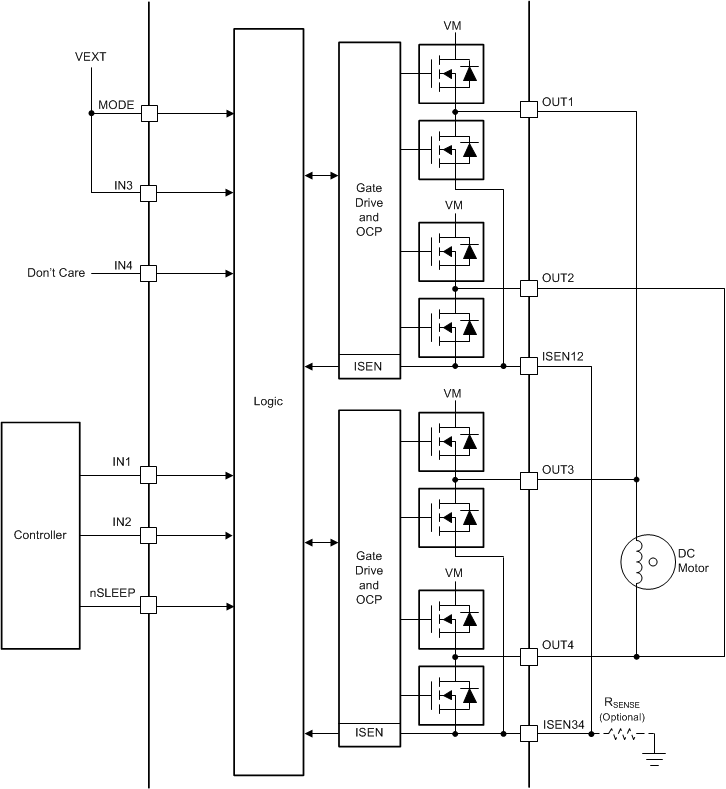SLVSE65C July 2018 – December 2023 DRV8847
PRODUCTION DATA
- 1
- 1 Features
- 2 Applications
- 3 Description
- 4 Revision History
- 5 Pin Configuration and Functions
- 6 Specifications
-
7 Detailed Description
- 7.1 Overview
- 7.2 Functional Block Diagram
- 7.3
Feature Description
- 7.3.1 PWM Motor Drivers
- 7.3.2 Bridge Operation
- 7.3.3 Bridge Control
- 7.3.4 Current Regulation
- 7.3.5 Current Recirculation and Decay Modes
- 7.3.6 Torque Scalar
- 7.3.7 Stepping Modes
- 7.3.8 Motor Driver Protection Circuits
- 7.4 Device Functional Modes
- 7.5 Programming
- 7.6
Register Map
- 7.6.1 Slave Address Register (Address = 0x00) [reset = 0x60]
- 7.6.2 IC1 Control Register (Address = 0x01) [reset = 0x00]
- 7.6.3 IC2 Control Register (Address = 0x02) [reset = 0x00]
- 7.6.4 Slew-Rate and Fault Status-1 Register (Address = 0x03) [reset = 0x40]
- 7.6.5 Fault Status-2 Register (Address = 0x04) [reset = 0x00]
-
8 Application and Implementation
- 8.1 Application Information
- 8.2
Typical Application
- 8.2.1 Stepper Motor Application
- 8.2.2 Dual BDC Motor Application
- 8.2.3 Open Load Implementation
- Power Supply Recommendations
- 9 Layout
- 10Device and Documentation Support
- 11Mechanical, Packaging, and Orderable Information
Package Options
Refer to the PDF data sheet for device specific package drawings
Mechanical Data (Package|Pins)
- PW|16
- PWP|16
- RTE|16
Thermal pad, mechanical data (Package|Pins)
Orderable Information
7.3.3.3 Parallel Bridge Interface
In the parallel bridge interface, the DRV8847 device is configured to drive a higher current BDC motor by using the driver in parallel to deliver twice the motor current. To go to parallel bridge interface operation, connect the MODE and IN3 pins to the external supply (3.3 V or 5 V) and use the IN1 and IN2 pins to control the driver. This mode can deliver the full functionality of the BDC motor control with all four modes (forward, reverse, coast, and brake mode).
Use this interface option for the following loads:
- One high current BDC motor (with or without current regulation) with full functional BDC modes (forward, reverse, brake, and coast mode)
- Two independent BDC motors operating together (with or without current regulation) with full functional BDC modes (forward, reverse, brake, and coast mode)
Table 7-5 lists the configurations for parallel bridge interface operation, and Figure 7-10 shows the application diagram for parallel bridge interface operation.
| nSLEEP | IN1 | IN2 | IN3 | IN4 | OUT1 | OUT2 | OUT3 | OUT4 | FUNCTION (DC MOTOR) |
|---|---|---|---|---|---|---|---|---|---|
| 0 | X | X | X | X | Z | Z | Z | Z | Sleep mode |
| 1 | 0 | 0 | 1 | X | Z | Z | Z | Z | Motor coast (fast decay) |
| 1 | 0 | 1 | 1 | X | L | H | L | H | Reverse direction |
| 1 | 1 | 0 | 1 | X | H | L | H | L | Forward direction |
| 1 | 1 | 1 | 1 | X | L | L | L | L | Motor brake (slow decay) |
 Figure 7-10 Parallel Mode Operation
Figure 7-10 Parallel Mode Operation